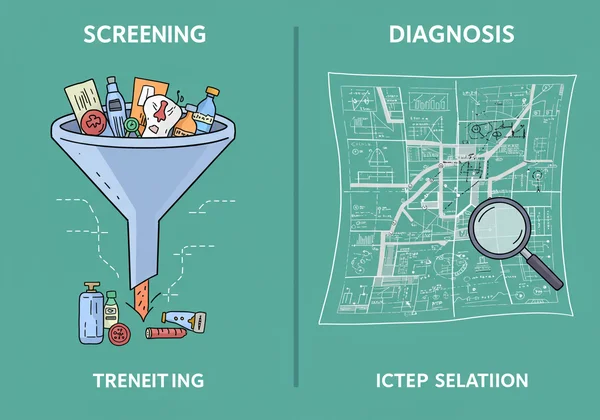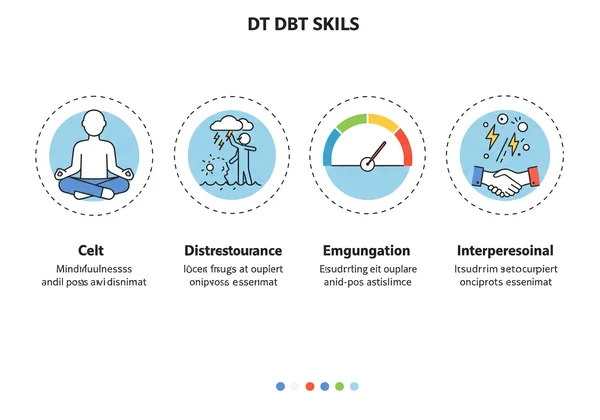Positive BPD Test: Your Next Steps for Diagnosis & Support
Receiving a result that suggests you might have traits of Borderline Personality Disorder (BPD) can bring a wave of complex emotions. You might feel a sense of validation, as if your struggles finally have a name. You might also feel anxious, confused, or overwhelmed about what comes next. If you've just completed an online BPD test, it's important to pause, breathe, and understand that this is a courageous first step, not a final destination. What do I do after a positive BPD test? This guide is your compassionate roadmap, designed to help you understand your preliminary results and empower you with clear, actionable steps toward professional clarity and meaningful support.
This initial screening offers powerful insights for self-awareness, acting as a catalyst to transform confusion into clarity. You've bravely taken the first step by seeking information; now, let’s explore the path ahead.
Understanding Your "BPD Likely" Test Results
Getting a "BPD likely" or similar result from an online quiz can feel significant, and in many ways, it is. It’s an indicator that your experiences align with common patterns associated with BPD. However, it's crucial to place these results in the correct context to avoid confusion and fear. Let's break down what this really means.
Screening vs. Diagnosis: Clarifying the Crucial Difference
The most important takeaway from your result is understanding the difference between a screening and a diagnosis. Think of the online BPD quiz you took as a weather forecast. It can tell you if there’s a high probability of rain, based on certain signs. This is incredibly useful for planning your day. However, it isn't the rain itself.
A screening tool like the one on our website is designed to identify potential risk factors or symptoms quickly. It’s a preliminary check, not a definitive conclusion. A formal clinical diagnosis, on the other hand, is like a detailed meteorological report conducted by an expert. It involves a comprehensive evaluation by a qualified mental health professional who can consider your full history, rule out other conditions, and provide an accurate assessment.

Navigating Initial Emotions: From Relief to Worry
It is completely normal to feel a mix of emotions right now. For some, seeing a "BPD likely" result brings a profound sense of relief. It can feel like validation that the intense emotional pain, chaotic relationships, and feelings of emptiness you've experienced aren't just "in your head." It provides a framework for understanding years of struggle.
For others, this result can spark fear and anxiety, often fueled by the stigma that unfortunately still surrounds BPD. You might worry about what this label means for your future. Acknowledge all these feelings without judgment. They are all valid parts of this process. This moment is not about labels; it's about opening the door to greater emotional validation and effective support.

Why Professional Evaluation is Your Essential Next Step
Because an online screening cannot provide a diagnosis, the single most important next step is to seek a professional evaluation. A trained clinician, such as a psychologist, psychiatrist, or licensed therapist, can conduct a thorough assessment. They will talk with you about your experiences, symptoms, and life history in a way a simple questionnaire cannot.
This step is essential for several reasons. It ensures you get an accurate diagnosis, as symptoms of BPD can overlap with other conditions like Bipolar Disorder, Complex PTSD, or depression. A professional can differentiate between these, which is critical for getting the right treatment. Taking the initiative to start your journey with a professional is an act of self-care and empowerment.
The Formal BPD Diagnosis Process: What to Expect
The idea of seeking a formal diagnosis can be intimidating, but knowing what to expect can make the process feel much more manageable. This is your path toward getting the specific, evidence-based help that can lead to healing and a more stable, fulfilling life.
Finding a Qualified Mental Health Professional
Your first task is to find a qualified professional who has experience with personality disorders. Start by searching for psychologists, psychiatrists, or clinical social workers in your area. When researching potential providers, look for those who list "Borderline Personality Disorder," "personality disorders," or "Dialectical Behavior Therapy (DBT)" among their specialties. Your primary care doctor can be a great source for a referral, and organizations like the National Alliance on Mental Illness (NAMI) often have resources to help you find local providers.

Preparing for Your Initial Clinical Appointment
To make the most of your first clinical appointment, a little preparation goes a long way. Consider bringing a printout or summary of your results from the free BPD screening. It can be a helpful starting point for the conversation.
Also, think about making a list of the specific symptoms or struggles that led you to take the test in the first place. Write down real-life examples. For instance, instead of just saying "I have mood swings," you could say, "Yesterday, I felt euphoric in the morning but was overwhelmed with sadness and anger by the afternoon after a minor disagreement." This concrete information is invaluable to a clinician.
Types of Assessments and Diagnostic Criteria (DSM-5)
A formal diagnosis is typically based on the criteria outlined in the Diagnostic and Statistical Manual of Mental Disorders, 5th Edition (DSM-5). This is the standard guide used by mental health professionals. The diagnosis process isn't a simple checklist; it's a comprehensive conversation. A clinician will conduct a structured interview, asking detailed questions about your emotional patterns, relationships, self-image, and behaviors.
They will assess whether you meet at least five of the nine specific criteria for BPD. This ensures the diagnosis is thorough and accurate, providing a solid foundation for your treatment plan. Remember, this evaluation is a collaborative process aimed at helping you.
Taking Control: Your Next Steps After a BPD Diagnosis
If you do receive a formal BPD diagnosis, please hear this clearly: it is not a life sentence of suffering. It is a roadmap to recovery. Modern, evidence-based treatments have made recovery from BPD not just possible, but common. This is where your journey of healing truly begins.
Exploring Evidence-Based Treatment Options (DBT & Beyond)
The gold-standard treatment for BPD is Dialectical Behavior Therapy (DBT). DBT is a type of therapy specifically designed to help individuals manage intense emotions, reduce self-destructive behaviors, improve relationships, and build a life they feel is worth living. It focuses on teaching four key skills: Mindfulness, Distress Tolerance, Emotion Regulation, and Interpersonal Effectiveness.
Other effective therapies include Schema-Focused Therapy (SFT) and Mentalization-Based Treatment (MBT). Discuss these options with your provider to see which approach is the best fit for you. The key is that there are proven, effective treatments available.

Building Your Support System: Friends, Family, & Community
Recovery is rarely a solo journey. Building a strong support system is a crucial part of the process. This might include trusted friends or family members who you can educate about BPD. Sharing reliable resources with them can help them understand your experience and learn how to support you effectively.
You may also find immense value in connecting with others who have similar experiences. Look for BPD-focused support groups, either locally or online. Sharing your struggles and successes with peers who truly understand can combat feelings of isolation and provide a powerful sense of community and hope.
Practical Strategies for Daily Living with BPD
While you work with a therapist, there are practical coping strategies you can begin to explore. Simple mindfulness exercises, like focusing on your breath for a few minutes each day, can help ground you when emotions feel overwhelming. Creating a predictable routine for sleeping, eating, and exercise can also provide a sense of stability.
Learning to identify your emotional triggers is another powerful step. When you start to recognize the situations or thoughts that lead to intense emotional reactions, you can begin to develop strategies to navigate them more effectively. This is about building a toolbox of skills to help you feel more in control.
Your Path Forward: Hope, Healing, and Empowered Living with BPD
Taking an online BPD test was your first step. It was an act of courage that opened the door to self-understanding. Whether your next step leads to a formal diagnosis or reveals that something else is at play, you are now on a path toward getting the answers and support you deserve.
A BPD diagnosis is not a definition of who you are; it is an explanation for your struggles and a guide to effective treatment. Recovery is possible. People with BPD go on to live stable, meaningful, and joyful lives. Embrace this hope and take the crucial next step: connect with a professional. You can understand your emotions better and build a brighter future.

Disclaimer: This article is for informational purposes only and does not constitute medical advice. Our website offers a preliminary screening tool and is not a substitute for a professional diagnosis. If you are in crisis or believe you may have a mental health condition, please consult a qualified healthcare professional. If you are experiencing a mental health crisis, please contact the 988 Suicide & Crisis Lifeline or your local emergency services immediately.
Frequently Asked Questions After a Positive BPD Test
Is a positive online BPD test a definitive diagnosis?
No, absolutely not. A positive result from an online screening like the BPD symptoms test indicates that you have symptoms consistent with BPD and should seek a formal evaluation. It is a helpful first step, but only a qualified mental health professional can provide an accurate diagnosis after a comprehensive assessment.
How do I get a formal diagnosis for Borderline Personality Disorder?
To get a formal diagnosis, you need to schedule an appointment with a mental health professional, such as a psychiatrist, psychologist, or licensed clinical therapist. They will conduct a clinical interview, discuss your symptoms and history, and use criteria from the DSM-5 to determine if you meet the diagnostic threshold for BPD.
What happens immediately after receiving a BPD diagnosis?
After a diagnosis, you and your mental health provider will work together to create a treatment plan. This typically involves discussing therapy options, with Dialectical Behavior Therapy (DBT) often being the first recommendation. The immediate goal is to help you stabilize, learn new coping skills, and start on the path to managing your symptoms effectively.
Can Borderline Personality Disorder be cured, or is it a lifelong condition?
While BPD is considered a serious condition, it is highly treatable. The term "cure" can be misleading, but with effective, long-term therapy like DBT, many people achieve "remission," meaning they no longer meet the diagnostic criteria for BPD. They learn to manage their emotions and build stable, healthy lives. The prognosis is far more hopeful today than it was in the past.
What are the common symptoms of BPD that are confirmed during diagnosis?
A diagnosis requires meeting at least five of nine criteria. The common symptoms of BPD include a frantic fear of abandonment, a pattern of unstable and intense relationships, an unclear or unstable self-image, impulsive and often dangerous behaviors, recurrent suicidal behavior or self-harm, intense mood swings, chronic feelings of emptiness, inappropriate and intense anger, and stress-related paranoia or dissociation. Taking a free BPD test can help you see if your experiences align with these patterns.